

Elkonin Boxes. Danielson’s Framework for Teaching. “We have been working in collaboration with Charlotte Danielson and the Danielson Group to create an important project—a collection of three full observations on film—that aim to show some of the intersections between Danielson’s Framework for Teaching and Workshop Teaching.

In 2013 many of the schools with whom we work were asked to adopt Danielson’s Framework for Teaching as a new initiative. We developed these videos and the accompanying resources out of an effort to help schools integrate the Framework for Teaching into strong reading and writing workshop instruction and to do this in ways that raise the level of literacy learning. Educational Leadership:Interventions That Work:The Why Behind RTI. Literacy How. “A coach is a teacher’s teacher.
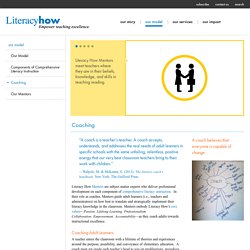
A coach accepts, understands, and addresses the real needs of adult learners in specific schools with the same unfailing, relentless, positive energy that our very best classroom teachers bring to their work with children.” —Walpole, M. & McKenna, S. (2013). The literacy coach’s handbook. New York: The Guilford Press. Literacy How Mentors are subject matter experts who deliver professional development on each component of comprehensive literacy instruction. Coaching Adult Learners A teacher enters the classroom with a lifetime of theories and experiences around the purpose, possibility, and conveyance of elementary education. Coaches: are supportive and non-evaluative.use insight and listening skills to influence the internal ideas that shape the external behaviors of teaching.build trust by maintaining confidentiality build team accountability by engaging administrators and appropriate staff.
Literacy Coaches Roles and Responsibilities - SEDL Letter, Reaching Our Reading Goals, Volume XVll, Number 1, June 2005. Home | SEDL Letter Archive by Sebastian Wren and Deborah Reed Published in SEDL Letter Volume XVll, Number 1, June 2005, Reaching Our Reading Goals For several decades, research findings have noted the importance of high-quality teachers to the reading success of students, especially students who are at risk for reading and academic failure.

While other factors, such as the quality of the core reading program and the teacher-student ratio in the classroom, appear to have some influence on reading achievement, the knowledge, skills, and experience of the classroom teacher seem to play a pivotal role in student reading success (Block, 2000; Bond & Dykstra, 1967; Brady & Moats, 1997; Darling-Hammond, 1988; Moats & Foorman, 2003; Sanders & Horn, 1998; Snow, Barnes, Chandler, Goodman, & Hemphill, 1997). SEDL program associate Stacey Joyner works with literacy coach Brenda Chavez at Bernalillo Middle School. There Is No Quick Fix. Using the RAFT Writing Strategy. Contribute to ReadWriteThink / RSS / FAQs / Site Demonstrations / Contact Us / About Us See more like this Our lesson plans are written and reviewed by educators using current research and the best instructional practices and are aligned to state and national standards.
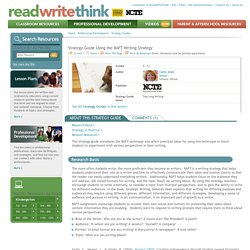
Choose from hundreds of topics and strategies. Five close reading strategies to support the Common Core. I walked in to my first college class, Political Science 101, eager to learn.

For my inaugural college assignment, my professor asked the class to read the first three chapters of the textbook for the next class period. That night, I returned to my dorm room, determined to learn everything I could in those three chapters. I pulled out my textbook and highlighter. Growing up, that is what I always saw the “older kids” using when they read a textbook. In my naïve 18-year-old mind, I believed that highlighters must have some magical power that transports the words on the page directly to your brain.
However, when I opened my textbook it was unlike anything I had read in high school. I shrugged, pulled out my highlighter and started highlighting. I quickly realized that I had no real game plan for reading this complicated textbook. Flash forward to my first few years of teaching. Every Teacher's Checklist for Struggling Readers. Students of all ages fall into the category of "struggling readers" and for a variety of reasons.
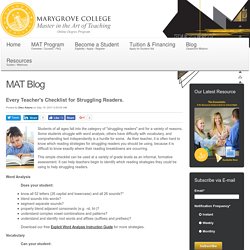
Some students struggle with word analysis, others have difficulty with vocabulary, and comprehending text independently is a hurdle for some. As their teacher, it is often hard to know which reading strategies for struggling readers you should be using, because it is difficult to know exactly where their reading breakdowns are occurring. This simple checklist can be used at a variety of grade levels as an informal, formative assessment. It can help teachers begin to identify which reading strategies they could be using to help struggling readers. Word Analysis Does your student: Sight Words: Teach Your Child to Read. Comprehension Toolkit Series. What’s New in the Second Edition?

The new 2016 edition of the series includes everything from the original edition plus a new teacher’s guide, new online resources, and a new book, Content Literacy: Lessons and Texts for Comprehension Across the Curriculum; many new lessons integrate the strategies with science and social studies curriculum. Strategy and Lesson Books: The updated strategy books contain the same content and lessons from the original edition with an improved design and organization to make the teaching of comprehension more accessible and easier to integrate across the curriculum. ReadWriteThink. National Reading Panel. Note: The National Reading Panel was convened by Congress in 1999 and has not been reconvened.

The information on this page is provided for historical purposes only. The page is not being updated. Overview In 1997, Congress asked the NICHD, through its Child Development and Behavior Branch, to work with the U.S. Department of Education (ED) in establishing a National Reading Panel that would evaluate existing research and evidence to find the best ways of teaching children to read. Gradual Release of Responsibility. What Is Differentiated Instruction? Click the "References" link above to hide these references.
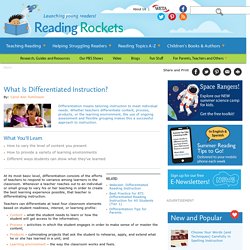
Csikszentmihalyi, M. (1997). Finding Flow: The Psychology of Engagement with Everyday Life. New York: Basic Books. Danielson, C. (1996). Enhancing Professional Practice: A Framework for Teaching. Teaching Reading K-2: A Library of Classroom Practices. 1.
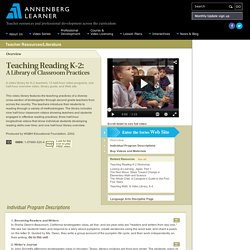
Becoming Readers and Writers In Sheila Owen's Beaumont, California kindergarten class, all five- and six-year-olds are "readers and writers from day one. " We see her students listen and respond to a story about pumpkins, create sentences using the word wall, and chant a poem on the letter D. Guided by Ms. Owen, they write a group account of the pumpkin life cycle, and then work independently on their writing.
K-5 Balanced Literacy Resources. Thank you for joining ReadWorks.org! How To: Master Spelling or Sight Words: Cover-Copy-Compare. This intervention promotes the acquisition of spelling or sight words. The student is given a sheet containing words to practice. The student studies each word on the sheet, covers the word briefly and copies it from memory, then compares the student-copied word to the original correct model (Joseph et al., 2011; Skinner, McLaughlin & Logan, 1997). Materials: Procedures: Here are the steps of Cover-Copy-Compare for spelling or sight words: STEP 1: [Teacher] Create a Cover-Copy-Compare wordlist. STEP 2: [Student] Use the Cover-Copy-Compare procedures.